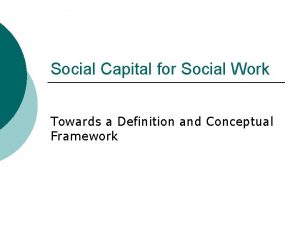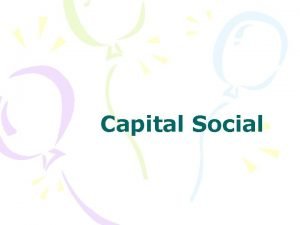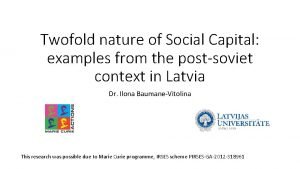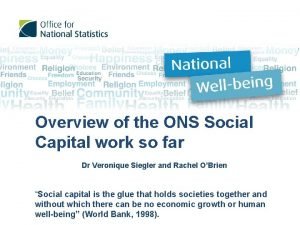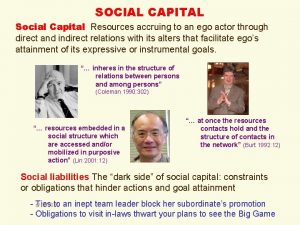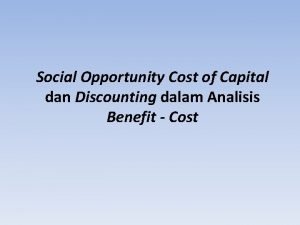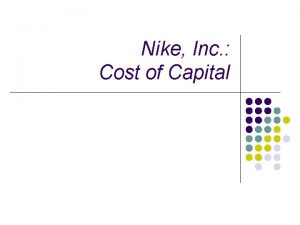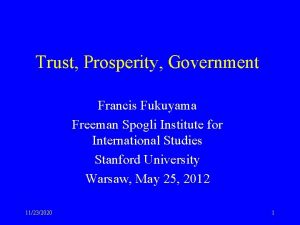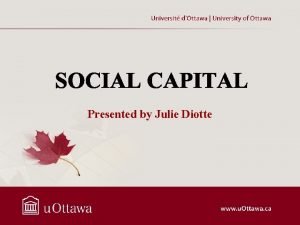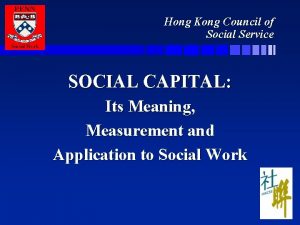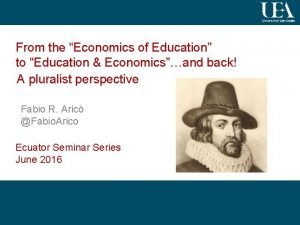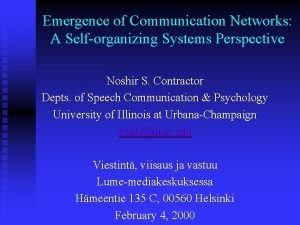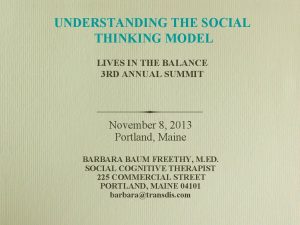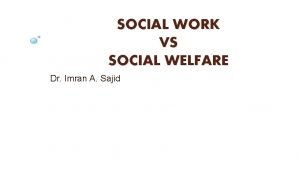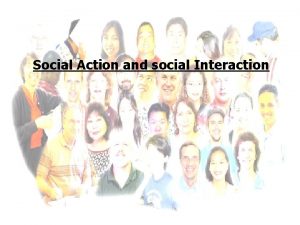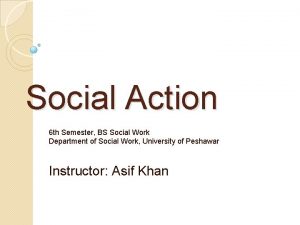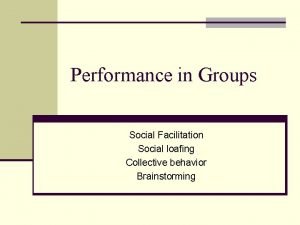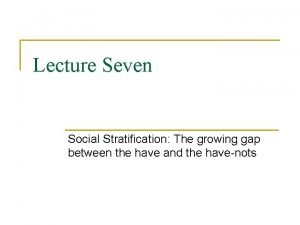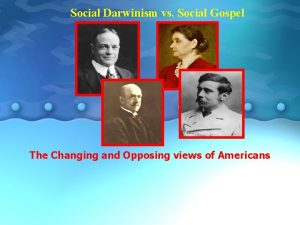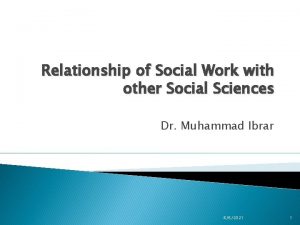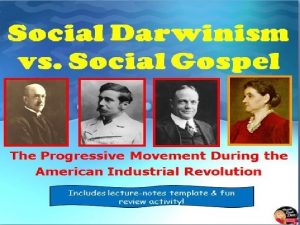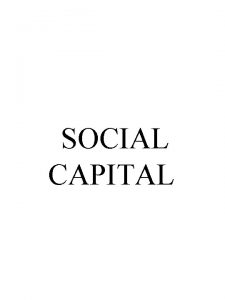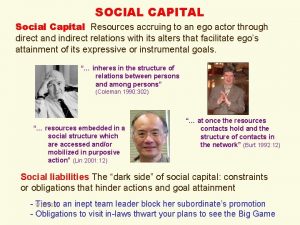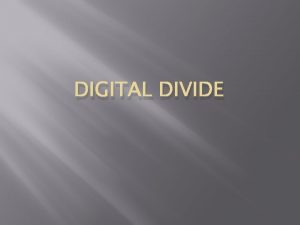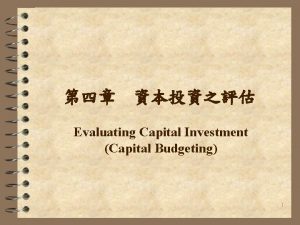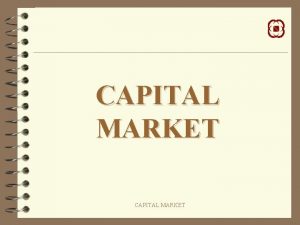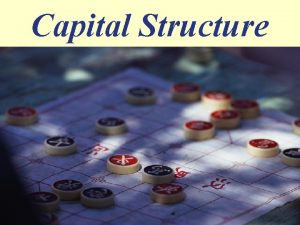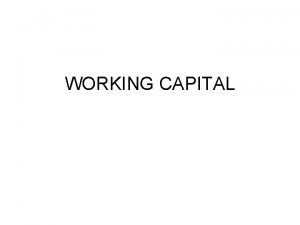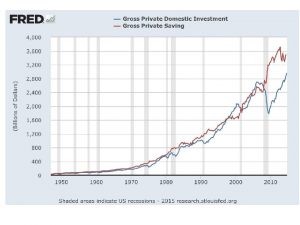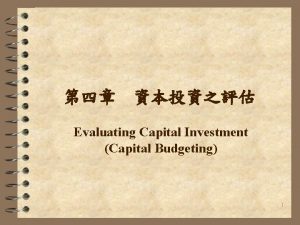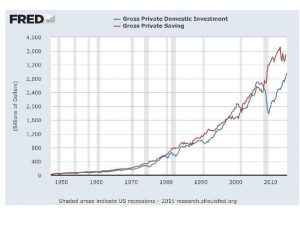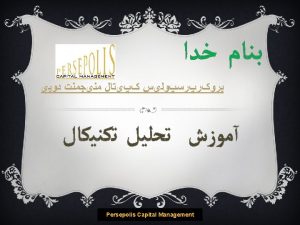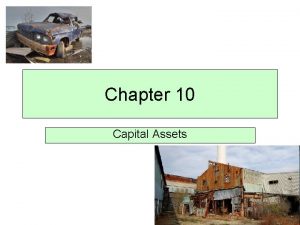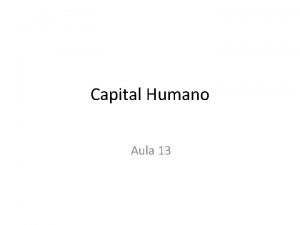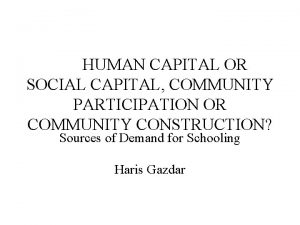Social Capital Social Capital Social Capital Social Capital




































- Slides: 36

Social Capital

Social Capital

Social Capital

Social Capital

Social Capital v. Now organizations are not viewed only from the internal efficiency and opportunistic aspect. It is also viewed from its position in the society. v. While analyzing organizations, the present organizational theorists synchronize different societal aspects in organizational relations. v. Social capital is one of those social concerns which recently get enough priority from the organizational theorists.

Social Capital Definition v. Social capital is a collective resource of a society which can be shared from social relations. v. According to Putnam (1995) social capital ”refers to features of social organization such as networks, norms, and social trust that facilitate coordination and cooperation for mutual benefit. ” v. Social capital is collective goodwill.

Social Capital Definition. . continued v. It can be considered as an asset of an individual, but it can also be viewed at the community or firm level. v. Network theory provides a key essence in forming, validating, and extending social capital theory

Social Capital • Dimensions or types of social capital Social capital is often divided into two forms or types: • Cognitive social capital • Structural (Hjerppe, 2003; Chou, 2006). Cognitive social capital encompasses norms and trust. Structural social capital includes social networks: both formal and informal.

Social Capital Cognitive • Trust and norms are related and encourage people to interact with others and organizations in • Norms can be viewed as a society which develops social contract or capital. unwritten rules, for example, norms of helping • On the other hand, one and cooperating people in important norm is reciprocity society is good citizenship (Fountain, 1998): people act for benefit responsibility. of others and expect to get help in return when it is needed. • Trust is confidence in reliability of others. The • Therefore, in case of high trust, trust that people have in the expectations that others will other people or in different reciprocate are high and people institutions like police, tend to really follow the civic government, , banks, norms in their actions (Knack and Keefer, 1997). media, etc.

Social Capital: Structural • Informal networks are formed by the interpersonal relationships between friends, relatives, colleagues, neighbors, etc. • Formal networks refer to participation in the associations and voluntary organizations: professional, religious, cultural, etc.

Social Capital • Three forms of networks • Intracorporate • Strategic • industrial district

Social Capital Characteristics of Social Capital v. The role of trust on social relation in individual level, and also for strategic alliance and industrial district networks is very important v. Benefits, risks, and learning aspects of social capital from the managers’ perspective is an important issue. v. The construct of social capital comes from goodwill and it is a function of social position and flourish through social relation.

Social Capital Characteristics of Social Capital. . continued v. Social relation and social capital is mutually dependent. v. The formal social structure is important for social capital. v. Social network is a static media and the effect of knowledge transfer of social capital depends on this static media.

Organizational Culture Dark Side of Organizational Culture v Willmott (1993) is straightforward to define its mission to criticize the dark side of organizational culture. v It reveals that corporate culture exploits employee’s feelings and morality. v Though corporate culture literatures perceive strong organizational culture as autonomy of individuals, the author believes it as the bindings of employees to comply with organization’s objective by giving up self-morality. v Actually, this is the ultimate goal of market economy.

Critical Theory

Critical Theory • Critical theory, modernism, and postmodernism, in the advanced stage of capitalism, are intellectual traditions most familiar to people who work in organizational behavior and culture, sociology, philosophy, aesthetic theory, feminism, and literary criticism. • The contemporary economical and political doctrines, which evolved, especially in Europe and Canada, are social capitalism, liberal democracy, and social democracy etc. • The conflicts in these intellectual discourses are significantly high especially from economical and political perspectives.

Critical Theory • Critical theory primarily is a theoretical approach developed by the Frankfurt School of German social thinkers, who believe that all knowledge is historical. • Modern organizational relation is based on power. Organizational process is grounded on domination and control, and outcome is oppression of employees.

Critical Theory • Critical theory integrates all major social science theories those shed light on society, including economics, sociology, history, political science, anthropology, and psychology. • Fundamentally, critical theory seeks human emancipation and liberates human beings from the circumstances that enslave them. • Following Horkheimer's definition, a critical theory is adequate only if it has three merits: it must be explanatory, practical, and normative, all at the same time. • That means, it must explain what is wrong with current social structure and relation, identify the sources of myths in present reality and actors to change it, and provide both clear norms for criticism and achievable practical goals for social transformation.

Critical Theory • Globalization, proliferation of information technology, productivity, and quality control are achieved in modern organizations at the expense of more control of the employees

Critical Theory • one is critical social • Historically critical theory which analyzes theory, inspired by social irregularities and moral philosophy of inequalities critically and Weber and advocates for social socioeconomic aspect transformation, of Marx and founded • and the other one is by Horkheimer, has critical literary theory two principal which presents critical view about texts, doctrines, literature, and knowledge transformation.

Critical Theory • Conventional mythical accent of organizational culture is rooted in its discourses and production management tools. • Management practices are grounded on productivity, quality control, lowering price, and globalization. • But the question is who is paying the cost? • Profitability and productivity are for the owners of capital of organizations at the expense of employees’ knowledge, education, and personal life.

Critical Theory • “The modern corporation has emerged as the central form of working relations and as the dominant institution in society. • In achieving dominance, the commercial corporation has eclipsed the state, family, residential community, and moral community. • This shadowing has hidden or suppressed important historical conflicts among competing institutional demands. • Corporate practices pervade modern life by providing personal identity” (Deetz, 1992).

Critical Theory Power, domination, and control are sequential process of modern organizational relation. • Critical theory does not negate or abandon modernism; rather it unveils sources and structures of organizational repressions in modernism and attempts to locate new dialectic relation which will ensure human emancipation. In this way, critical theory realizes that destabilizing modernism or capitalism is not the solution, rather finding the sources of oppression and removing these are the solutions. • It highlights process of organizing in organizational structure with outcome of organizational functions.

Critical Theory • Modern management techniques remove hierarchical relations and bureaucratic administration, transfer more responsibilities among employees, however, these techniques ultimately impose more control among the employees. • Modern organizations fulfill customers demand at the expense of employee oppression. • Although different modern management tools are obviously designed to fulfill customers need, their rooted and ultimate purpose is not to fulfill customers demand rather to fulfill the organization’s self-interest like, sustainability, productivity, and profitability.

Postmodernism • Postmodernism does not invoke any specific theory about study of organization, realm of science, epistemology, ontology, or sociology. • Postmodernism is comprehension of some dynamic paradigms, analytical conjectures, arguments, and conceptual views which supplement unanswered questions of modern theories. • Chia (1995) asserts that modernism and postmodernism are fundamentally distinguishable on the aspect of style of thinking. • The author thinks that postmodernity justifies organizations from subjective matters whereas modernism views it from objective reality.

Postmodernism • Postmodernism conceptualizes reality not as a discrete phenomenon; rather it is interconnected with different issues which reflect complex and dynamic nature of organizations, society, and the universe. • Postmodernism denies the primacy of static and stable situation in organizations • Postmodern view relies on change, emergence, and transient state of organizations. • Interesting point to note here that, postmodernism views organization relation from organizing process.

Postmodernism • Suppose Law (1992) negates the notion of individual entity, thus explain organizational relations as • “What counts as a person is an effect generated by a network of heterogeneous interacting materials…. People are who they are because they are a patterned network of heterogeneous materials” • Modernism and postmodernism are two different states and recognizes organization as a symbolic entity (Baudrillard, 1981) • Negation and failure of modernism initiates evolution of postmodernism.

Postmodernism believes on the particular modes of knowledge defined by the multiplicity of people’s subjective position. It rejects the enlightenment attempt to create a universal knowledge. • • Postmodernism overviews the relation between power and control from organizing process, however, does not affirm the outcome of control. It negates not only modernism but also total objectivity and self-identity of human emancipation and workers’ oppression as a specific reality.

Postmodernism • Most of the postmodernists fail to conceptualize political aspect in their theorization aiming to comment on modernism. • Foucault (1977) also fail to get a political position (Fraser, 1989), • • Postmodernism totally rejects objectivism, specificity, reality, and identity. Postmodernism conceptualizes employees in organizations individually as a group. It is sometimes identical to mechanistic view of advanced capitalism.

Postmodernism • In application stage, postmodernism depends mostly on epistemological and ontological view about change of world and production relation in terms of feudalism and capitalism from premodern to modern era. • However, if postmodernists believe that difference of modernism from postmodernism is grounded on economical aspect, then they would have been focused more on relevant issues in this regard, like capitalism, hegemony of market economy, production relation, and globalization.

Postmodernism • But, on the ground of subjectivity, they do not conceptualize these issues as relevant, because these concepts are grounded on objective reality. • Since they do not conceptualize those relevant terms or declare the death of modern market economy, though negates modernism while developing paradigms of postmodernism on economical aspect, their paradigm that failure of modernism initiates postmodernism seems to be grounded on weak logical consequence.

Postmodernism v Modern organizational productivity and efficiency are based on imposing more control and discipline among employees. v This control (Perlow, 1998) has severe negative impact on employees in relation to their social and family life. v But postmodernism evaluates these different phenomena individually. v As a result, by segregating mainstream into several branches, postmodernism undermine the significance of mainstream of employee oppression in modern organization. v However, critical theory looks at the root of oppression in organizational life and evaluates the mainstream.

Postmodernism • Foucault’s postmodern theory (1978) of discipline stresses the inherent resistances that people might have against their labeling and differential treatment. • This is a prominent and popular view of proponents of modernism. It is also controversial. Many organizational theorists disproved this consciousness of employees (Agger, 1991; Willmott, 1993; Parker, 1995; Box, 2005). Who will make them conscious and how? • International media is always in favor of modernism and tries to advertise that what is happening in organization and in society is for the betterment of employee.

Postmodernism • Even in this respect, Foucault’s postmodern theory confronts with Baudrillard (1983). Baudrillard suggests that reality (he defines it hyperreality) is increasingly simulated for people, developed by powerful media and other cultural and societal sources. • Public are unable to distinguish between these simulations and reality. So, who is hiding the truth (if not truth is relative according to postmodernism!)? • Postmodernism like theological doctrine intends to propagate that, since employees are not resisting modern organizational relation, there is no true suppression in organizational life as the outcome. • Critical theory sheds light on organizational relation and organizational outcome from the side of employees.

Postmodernism • Postmodernism overlooks human emancipation. Because, postmodernism, especially skepticism, thinks that there is no absolute meaning of emancipation, rather it is just a relative realization, transfer from one stage to another. • This is something consistent with theological philosophy. In this way, though postmodernism also identifies oppression in modern organizational process, postmodernism does not pull the dialectic organizational relation in the center of problematic agency of organization.

Postmodernism • The hidden mission of postmodernism in criticizing and negating modernism is to move to further stage of advanced modernism by protecting present production relation and by resisting objective meaning of emancipation of employees. • But, critical theory primarily plays for the sake of the emancipation of employees.
 Working capital management introduction
Working capital management introduction Source of capital reserve
Source of capital reserve Multinational capital structure
Multinational capital structure Difference between capital reserve and reserve capital
Difference between capital reserve and reserve capital Regulatory capital vs economic capital
Regulatory capital vs economic capital Regulatory capital vs economic capital
Regulatory capital vs economic capital Variable capital examples
Variable capital examples Multinational cost of capital and capital structure
Multinational cost of capital and capital structure Capital allocation line vs capital market line
Capital allocation line vs capital market line Social thinking and social influence in psychology
Social thinking and social influence in psychology Social thinking social influence social relations
Social thinking social influence social relations Apa yang dimaksud dengan social opportunity cost rate
Apa yang dimaksud dengan social opportunity cost rate Capital social def
Capital social def Concepto de capital
Concepto de capital Exhibicion decretada
Exhibicion decretada Social capital examples
Social capital examples Social capital examples
Social capital examples Social capital resources
Social capital resources Opportunity cost of capital
Opportunity cost of capital Capital social nike
Capital social nike Capital social
Capital social O que é capital social
O que é capital social Social capital
Social capital Social capital definition
Social capital definition Capital social
Capital social Capital social
Capital social Remuneração convencional do capital social
Remuneração convencional do capital social Double interview michelle garcia winner
Double interview michelle garcia winner Social welfare vs social work
Social welfare vs social work Difference between social action and social interaction
Difference between social action and social interaction Principle of dramatization
Principle of dramatization Diener 1976 trick or treat
Diener 1976 trick or treat Models of group work in social work
Models of group work in social work Social stratification vs social inequality
Social stratification vs social inequality Social gospel vs social darwinism
Social gospel vs social darwinism Relationship between political science and social work
Relationship between political science and social work Social darwinism vs social gospel
Social darwinism vs social gospel












